Hardscape design is one of the most exciting topics a homeowner can dive into. What is it, exactly?
In a nutshell, hardscape design encompasses the placement of non-living elements of a landscape: walkways, patios, fences, lighting, retaining walls, arbors, rocks etc.
Effective hardscape design adds function, greater enjoyment, and value to your home. For over 28 years we’ve been in the business of solving unique landscape problems. We know how to provide creative solutions to transform your outdoor spaces, and can guide you in renovating the ordinary into the perfect. Check out these recent samples of projects that have been fun to work on:
Hardscape Design for a ‘Home Away from Home’
 These avid travelers presented us with an interesting challenge. Could we ‘naturalize’ a look around their comfortably-sized RV, which they keep securely parked in front of their home?
These avid travelers presented us with an interesting challenge. Could we ‘naturalize’ a look around their comfortably-sized RV, which they keep securely parked in front of their home?
A direct approach, blending hardscape design with horticultural elements, was the answer.
- Low-profile lighting, a custom concrete pad, and fencing provide needed structure and privacy.
- Attractive groupings of native plantings is laid out in harmony. As the plants grow up and mature, they’ll provide additional screening, softening the RV surround with a naturalized feel.
Hardscape Design Trifecta: Yard, Garden, Patio

These homeowners won big with a hardscape design that accomplished three things at once:
- A raised garden bed made of retaining wall blocks is sturdy, accessible, and ideal for supplying their kitchen with fresh herbs and edibles.
- The gravel surround and dry creek bed act as natural dividers for the different uses in the new yard, and also reduce thirsty lawn space without sacrificing it completely.
- A handsome paver patio allows this family to extend the hospitality of their home.
Hardscape Design on a Dime: Gravel Paths and Pathways
Inexpensive and multi-purpose, gravel paths pair nicely with a variety of border elements, and their texture can be quite pretty when set against a lush lawn or garden.
Pictured below: Gravel dressed with bricks and pavers combine for a decorative approach in lawn and gardenscapes, while a simple partnership with 6×6 pressure-treated timbers provides instant, well-drained access to service areas alongside a home.

Feeling inspired? Our expert team is ready to help. Let us transform your outdoor space with a creative hardscape design that adds function, increases enjoyment, and adds value to your home. Let’s Get Started!

Spring brings sunnier days and the promise of warm growing weather before too much longer. As you envision enjoying a bounty of flowers and home-grown veggies, consider the ways a thoughtfully-designed retaining wall can materially increase your decorative and functional garden space.
Retaining walls remain one of our top residential installation projects due to their versatility in function and style. Besides the traditional benefits of terracing (for homeowners dealing with a steep gradient in the yard), a handsome retaining wall can be a simple key to bringing fresh inspiration to an ordinary landscape.
Manicured Look
An interesting bed filled with colorful flowers adds visual appeal and an upscale feel to your yard. Plantings can be tailored to attract hummingbirds, butterflies, or used as a cutting or vegetable garden. Bulbs, shrubs and trees can also be combined to offer striking arrangements with evergreen interest year round.
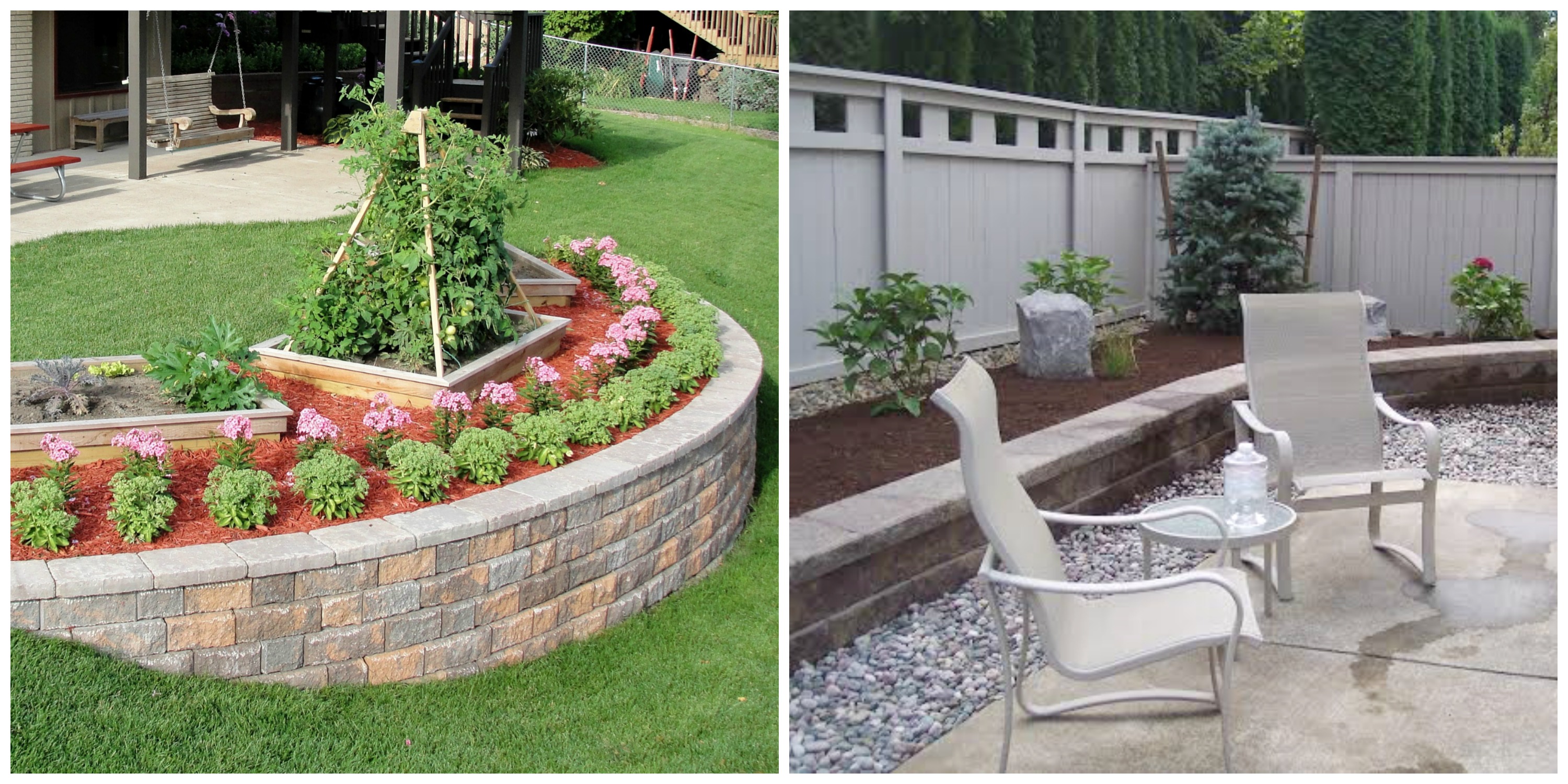
Enhanced Outdoor Living
Bring fragrant, eye-catching blossoms closer to eye- and nose-level around outdoor seating areas so you can readily savor their scent and beauty throughout the season.
Improved Yard Definition
Retaining walls function as natural dividers to separate your edible garden from recreational yard space in a natural way. Keep herbs, fruits and veggies growing close to the kitchen, while leaving the yard available for summer play.
Convenient Raised Beds
Retaining wall blocks make ideal raised bed frames and can be installed as a convenient quick-start for an easily maintained garden. An added benefit: blocks act as heat sinks. The soil within will warm sooner each spring and also keep warm longer in the fall than a traditional garden.
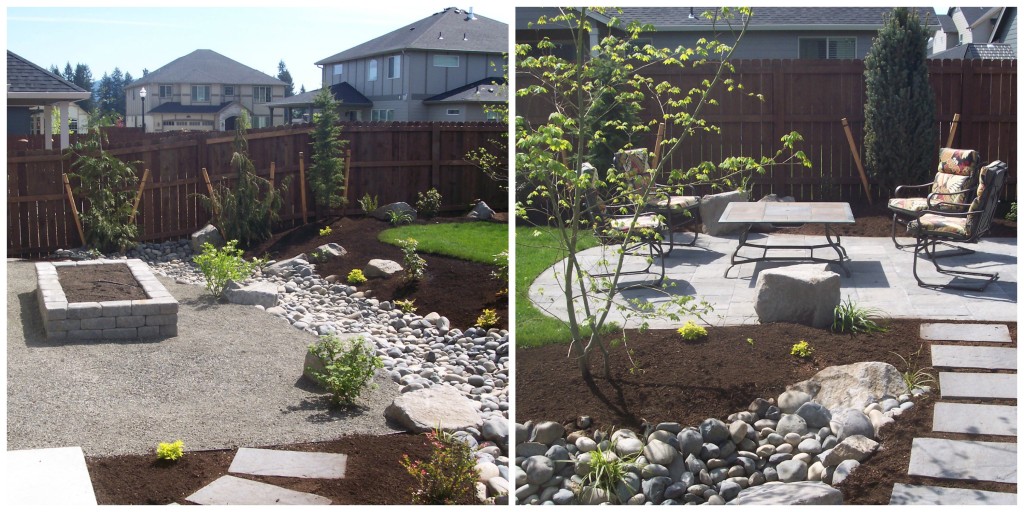
A recent installation in Vancouver, WA.
An unstructured lawn space was transformed through the addition of an inviting outdoor living area linked to a gardening area featuring a raised bed made of blocks. The patio, pathway, dry creek bed, and gravel surround are interspersed with hardy native plants for a natural feel.
Retaining Wall Design for Small Spaces
Frontier collaborated as part of the WALP* team delivering expert treatment for a postage-stamp sized “yard” in this display during the Clark County PUD Home Show on April 21st-24th. Retaining walls are relevant in a range of sizes and shapes, from small accent beds like this example to large-scale ornamental features in a yard or patio area.

Get a Bid
Frontier Landscaping builds all types of retaining walls, working with you to determine the right materials and composition to achieve the look you want and functionality you need.
Give us a call. We’d love to work with you and bring more enjoyment and usability to your yard and garden this season.
*We’re proud to be members in good standing of the Washington Association of Landscape Professionals: committed to professionalism, integrity, and continuing education in our industry.
What a beautiful time of the year with the rhododendrons, magnolias, camellias, forsythia and other spring flowering plants reaching their peak of beauty. There are a few April garden tasks one can do to keep the garden looking its best this season. Remember what is accomplished early in the season will help cut down on garden maintenance the rest of year.
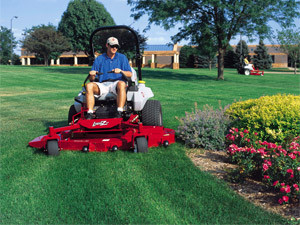 LAWN CARE
LAWN CARE
Now is a good time to give some attention to the lawn. The application of a spring lawn fertilizer will perk up the lawn and improve overall color and appearance. If needed, get one that includes moss killer. Most lawns could use aerating now, and, if necessary, a thatching. Applying new grass seed fills in the lawn and deters moss and weeds. Use about one pound per 300 square feet. Call Frontier today to find out how our landscape services can make having a lush, beautiful lawn.
FRUITS & BERRIES
Local garden outlets have their finest selection of fruit trees and berry plants this time of year. All types of fruits and berries do best when planted in full sun – consider a small back yard orchard this year!
VEGETABLES
Amazingly, it’s time to get the vegetable garden underway in earnest. Plant perennial vegetables like asparagus, rhubarb, horseradish now. You can plant cool weather veggies: peas, carrots, beets, greens of all sorts, cauliflower, cabbage and more. Wait until later this month to plant beans and corn. Don’t put in warm weather crops like tomatoes, squash, cucumbers and peppers until next month.
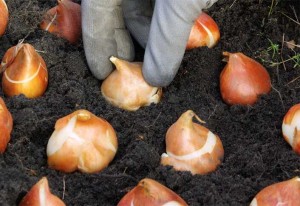 SUMMER-FLOWERING BULBS
SUMMER-FLOWERING BULBS
If you missed the fall window for planting spring flowering bulbs such as tulips and daffodils, you needn’t miss this opportunity to plant summer-flowering bulbs including dahlias, gladiolas and lilies. Mix bulb fertilizer, processed manure and peat moss into the soil and check the instructions for proper depth.
TREES & SHRUBS
There is still time to plant trees, shrubs, perennials and other plants. Rockery perennials and hardy annuals may also be planted at this time.
PRUNING
April and May are ideal for pruning or shearing evergreens such as junipers, conifer and cypress. However, if you cut back into bare branches it can be difficult or impossible for the plant to regrow. Optimize your evergreens with an expert pruning by Frontier Landscaping’s team of professionals.
Windy areas can pose problems that keep you from having an enjoyable yard or commercial landscape. Even slight breezes are inconvenient in picnic areas.
If you’re plagued by whipping winds, you can create effective windbreaks that protect specific outdoor living spaces to make them far more comfortable. There are three ways to create a windbreak or screen.
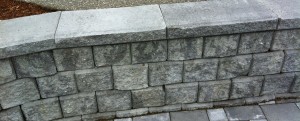 Fences and walls are highly effective at deflecting wind away from small, often-used outdoor living spaces. They can be costly, though, particularly if you opt for transparent materials that allow light to pass through. Not surprisingly, they also need to be well reinforced.
Fences and walls are highly effective at deflecting wind away from small, often-used outdoor living spaces. They can be costly, though, particularly if you opt for transparent materials that allow light to pass through. Not surprisingly, they also need to be well reinforced.
Short, dense shrub hedges around living spaces, allowing users to sit in the protected area while gazing over the top of the barrier at the view. Though it lacks a view, 10-foot tall shrubs are the answer for greater wind reduction.
Shrub hedges take time to mature and reach their full effectiveness. If you choose hedges that naturally reach the desired height, you can allow them to grow into their natural shape. With other choices, size and shape may be controlled by regular pruning or shearing.
Landscape designers are moving toward a more diverse combination of different shrubs for protective diversity. Not only does this add interest; it also protects the hedge should certain varieties by struck by a pest or disease.
‘Windrows’ – a single row of identical trees planted close together – have long been used by farmers to protect fields, orchards and home sites. It can work just as well for your landscape. As trees mature, in some cases to 30 feet depending on variety, they can significantly change the micro climate. There is no other way to create a similarly sized wind barrier.
Windrow trees tend to be tall and narrow with dense foliage for maximum wind blockage. Many evergreens make good windrows.
The downside to using trees for wind control is that they take time to mature. The early years may have little to no reduction in wind. Planting larger, older trees is not viable because they will not have time to develop a sufficient root system to anchor them against gale force winds.
Fortunately, your office building or home needn’t be whipped by gusts of wind, or many other common landscape challenges for that matter. Frontier Landscaping’s services include remedies for just about any landscape challenge you’re facing.

Noisy neighborhood? Try these tactics.
While you can’t totally block out noise, several noise reduction strategies exist that can go a lot way toward mitigating noisy surrounding to make them less bothersome.
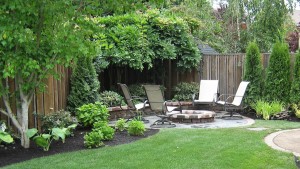 Did you know you can absorb sound with plants of all sorts? Their leaves, branches, and wood entrap the vibrations. Best when employed as close to the noise source as possible, this method is commonly used for large scale applications.
Did you know you can absorb sound with plants of all sorts? Their leaves, branches, and wood entrap the vibrations. Best when employed as close to the noise source as possible, this method is commonly used for large scale applications.
Trees with rough bark are effective at scattering sound waves. Deciduous plants lose their effectiveness when leaves fall, but leaf out for maximum advantage during the months when windows are open and you’re spending more time outdoors.
Hedges for Noise Reduction
Consider planting hedges in order to create a noise barrier. These plants can create dense screening between you and your neighbors and outdoor noises that may interfere with enjoying your landscape.
Partitions can cause sounds to be bounced away from the recipient and sometimes back toward the source.
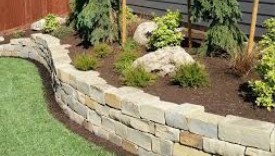 When sound waves strike a 5- or 6-foot masonry wall, it does not vibrate and they are reflected back toward the source. The sound waves that are higher up travel across the wall more readily, which is why plants along the wall and/or vines that grow over the wall enhance its effectiveness.
When sound waves strike a 5- or 6-foot masonry wall, it does not vibrate and they are reflected back toward the source. The sound waves that are higher up travel across the wall more readily, which is why plants along the wall and/or vines that grow over the wall enhance its effectiveness.
When sound waves strike a slightly flexible panel it will vibrate. This transforms sound waves into other forms of energy and deflects them in different directions. The more flexible the material, the greater the deflection. Common materials are fiberglass and corrugated metal.
White noise
If a room is empty with a bare floor and walls, every sound bounces off the hard surfaces to magnify it or even cause a slight echo as it bounces around. Add carpeting and the echo vanishes. On the ground plane the most powerful tool is a lawn, due to its large area and excellent refraction ability.
 Fountains and other water features provide a pleasant ‘white noise’ that is appealing to the human brain as a mask for undesirable noise. The most widely used method is a fountain that makes loud splashes. Coupled with other noise-reducing methods, even a smaller fountain becomes far more effective than you might think.
Fountains and other water features provide a pleasant ‘white noise’ that is appealing to the human brain as a mask for undesirable noise. The most widely used method is a fountain that makes loud splashes. Coupled with other noise-reducing methods, even a smaller fountain becomes far more effective than you might think.
Working with a professional landscaper will help you get the most out of your efforts. Walls, lawns, plantings and landscape installation are among the expert landscaping services Frontier Landscaping is proud to provide.
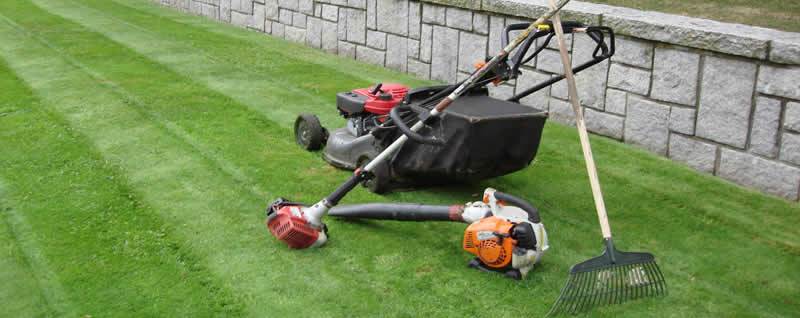
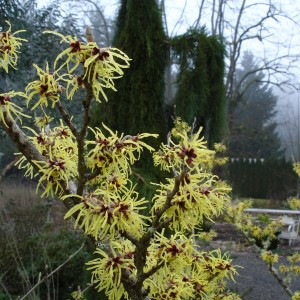
Capricious as March may be in her whims of weather, taking on a few of these spring garden tasks – even if between showers – will spruce up your landscape and lay the groundwork for a great growing season.
A clean sweep of decluttering, purging and tidying now will reward you with a fresh palette and greater options going forward.
Remove dead, damaged branches
Tree and shrub branches that have been damaged by cold, snow and wind should be pruned back to live stems; use a handsaw for any larger than ½ inch in diameter.
Prune (some) shrubs
While it’s a good time to prune summer-flowering shrubs, such as Rose of Sharon, before buds swell, the ideal time to prune spring bloomers is right after they flower. However, you can also prune them while in flower and use the flowering stalks in arrangements for inside. Forsythia and lilacs are wonderful examples.
Prune roses
Cut back winter-damaged rose canes to 1 inch below the blackened area. On climbers, keep younger green canes and remove older woody ones; neaten them up by bending the canes horizontally and tipping buds downward. Use jute twine or gentle Velcro fasteners to hold the canes in place. This task is best accomplished with a pair of sharp bypass pruners – and good gloves!
Divide perennials
Prune flowering perennials to a height of 4-5 inches to allow new growth to shoot up. Where soil has thawed, dig up overgrown clumps of perennials, such as daylily and hosta, dividing them into smaller clumps to be shared or transplanted elsewhere.
Clear the decks
Rake fallen leaves and dead foliage from around the base of your plants; they can smother plants and foster disease. Pull up weeds and spent annuals and rake away existing mulch to make way for a new layer after spring planting. Use pins to fasten loose drip irrigation lines and a square-head shovel to give beds a clean edge and keep turf grass from growing into them.
Feed
Now is a good time to spread a pelletized fertilizer on the soil’s surface so that spring rains can carry it to the roots. Add 5-10-10 fertilizer around bulbs as soon as they flower to maximize bloom time and nourish next year’s growth.
Compost yard waste
A compost pile can be as simple as a small corral made by joining a section of wire fencing. Collected leaves, cuttings, spent foliage and other debris will decompose and create nutrient rich humus for amending your garden. Branches larger than 1/2 inch in diameter should be cut down or chipped to accelerate decomposition or add a bagged compost starter to the pile. Keep the pile as moist as a wrung-out sponge and aerate it with a pitchfork every two weeks. Early spring weeds may keep growing and go to seed. These and chemically treated plant material should be otherwise disposed of.
Prep lawn for spring seeding
Test your soil’s pH in various locations where your lawn will be and assemble the right amendments. Remove damaged, diseased turf to prepare for the seeding that should follow in a few weeks. You can remove dead turf with a square metal rake, then flip it over to spread compost. Work in a half-inch layer of compost to keep the new seed moist and increase the germination rate. Begin seeding once the forsythia starts blooming in your area.
 Clean up paths & patios
Clean up paths & patios
Rake escaped gravel back into aggregate walkways and patios and order more to spread in large depressions that often form near the driveway’s apron. Refill joints between flagstones by sweeping in new sand or stone dust; water with a hose to set it, then repeat. If the freeze-thaw cycle has heaved pavers out of place, remove them and replenish the base material as needed before setting pavers back in. Use a pressure washer with a low pressure tip to remove slippery algae spots or leaf stains from patios and walkways.
Restore worn wood fences
Remove badly rotted or damaged pickets, boards or lattice and scrub wood structures with a mixture of 2 gallons water, 2 quarts bleach and 1 cup liquid soap; let dry. Patch rotted sections with wood epoxy; install new wood as needed. Check wobbly fence posts to see if they need replacing. Scrape off old paint, then sand with 60 grit sandpaper to prep for a new finish coat. Once temperatures go above 50 degrees F, brush on a new coat of paint or stain.
Choose Frontier Landscaping for help with your spring landscape cleanup. We are based in Vancouver, Wash., and provide services in the Portland-Vancouver area and throughout Clark County, Washington.
Call today to find out how Frontier Landscaping can grant you the yard you’ve been wishing for.
 These avid travelers presented us with an interesting challenge. Could we ‘naturalize’ a look around their comfortably-sized RV, which they keep securely parked in front of their home?
These avid travelers presented us with an interesting challenge. Could we ‘naturalize’ a look around their comfortably-sized RV, which they keep securely parked in front of their home?







 LAWN CARE
LAWN CARE SUMMER-FLOWERING BULBS
SUMMER-FLOWERING BULBS Fences and walls are highly effective at deflecting wind away from small, often-used outdoor living spaces. They can be costly, though, particularly if you opt for transparent materials that allow light to pass through. Not surprisingly, they also need to be well reinforced.
Fences and walls are highly effective at deflecting wind away from small, often-used outdoor living spaces. They can be costly, though, particularly if you opt for transparent materials that allow light to pass through. Not surprisingly, they also need to be well reinforced.

 Did you know you can absorb sound with plants of all sorts? Their leaves, branches, and wood entrap the vibrations. Best when employed as close to the noise source as possible, this method is commonly used for large scale applications.
Did you know you can absorb sound with plants of all sorts? Their leaves, branches, and wood entrap the vibrations. Best when employed as close to the noise source as possible, this method is commonly used for large scale applications. When sound waves strike a 5- or 6-foot masonry wall, it does not vibrate and they are reflected back toward the source. The sound waves that are higher up travel across the wall more readily, which is why plants along the wall and/or vines that grow over the wall enhance its effectiveness.
When sound waves strike a 5- or 6-foot masonry wall, it does not vibrate and they are reflected back toward the source. The sound waves that are higher up travel across the wall more readily, which is why plants along the wall and/or vines that grow over the wall enhance its effectiveness.



 Clean up paths & patios
Clean up paths & patios